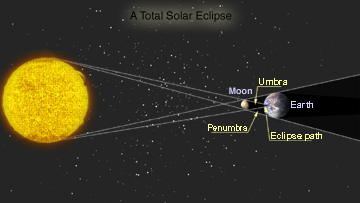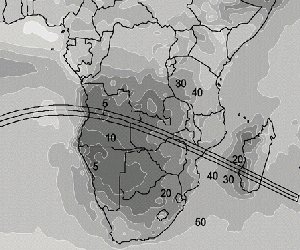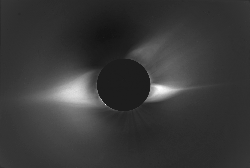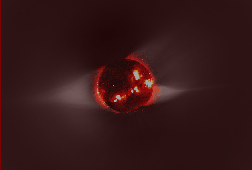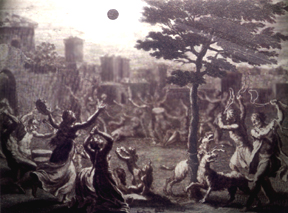Table of Solar Eclipses
Solar eclipses have been recorded for many years. There are three different types of solar eclipses: partial, annular and total. A partial eclipse occurs when only part of the Sun is hidden by the Moon. A total eclipse occurs when the Sun is completely hidden by the Moon.An annular is a special type of eclipse. During a normal total eclipse, the umbra of the Moon casts a shadow onto Earth. The shadow changes with the eclipse, and shows the patterns as the form. During an annular eclipse, the umbra doesn't reach the Earth.
| Date | Area viewed from | type |
|---|---|---|
| November 3, 2013 | Gabon, Republic of the Congo, Democratic Republic of the Congo, Uganda, Kenya, Ethiopia | total/annular |
| May 10, 2013 | Australia, Louisiade Archipelago, Solomon Islands, Kiribati | annular |
| November 13, 2012 | Australia, New Zealand | total |
| May 20, 2012 | southern China, Hong Kong, Macau, Japan, western United States | annular |
| November 25, 2011 | South Africa, Antarctica, Tasmania, New Zealand | partial |
| July 1, 2011 | Southern Indian Ocean near Antarctica | partial |
| June 1, 2011 | Iceland, northern Canada, Alaska, northeastern Asia, Greenland, northern Scandinavia | partial |
| January 4, 2011 | Europe, northern Africa, Central Asia, Middle East | partial |
| July 11, 2010 | South America, Polynesia | total |
| January 15, 2010 | Africa, southeastern Europe, Middle East, Asia | annular |
| July 22, 2009 | Asia, Melanesia, Pacific Ocean, Hawaii | total |
| January 26, 2009 | Southern Africa, East Antarctica, Southeast Asia, Australia | annular |
| August 1, 2008 | Eastern Canada, Greenland, northern Europe, Asia | total |
| February 7, 2008 | Antarctica, Australia, New Zealand, Melanesia, Micronesia, Polynesia, West Antarctica | annular |
| September 11, 2007 | South America, Antarctic Peninsula, East Antarctica, South Atlantic | partial |
| March 19, 2007 | Asia, Western Alaska | partial |
| September 22, 2006 | Northern S. America, S. Atlantic Ocean | annular |
| March 29, 2006 | Brazil, Africa, Turkey, Kazakhstan | total |
| October 3, 2005 | Spain, Portugal, Africa | annular |
| April 8, 2005 | S. Pacific, South and Central America | annular/total |
| October 14, 2004 | NE Asia, Hawaii, Alaska | partial |
| April 19, 2004 | Antarctica and S. Africa | partial |
| November 23, 2003 | Australia, New Zealand, Antarctica | total |
| May 31, 2003 | Europe, Asia | annular |
| December 4, 2002 | S. Africa, Antarctica, Indonesia, Australia | total |
| June 10, 2002 | East Asia, Australia | annular |
| December 14, 2001 | North and Central America | annular |
| June 21, 2001 | Africa | total |
| December 25, 2000 | North and Central America | partial |
| July 31, 2000 | North Asia, NW North America | partial |
| July 1, 2000 | South Pacific, S. America | partial |
| February 5, 2000 | Antarctica | partial |
| August 11, 1999 | Atlantic, Europe, Middle East, India | total |
| February 16, 1999 | Indian Ocean, Australia | annular |
| August 22, 1998 | Indian Ocean, East Indies, Pacific | annular |
| February 26, 1998 | Pacific, Central America, Atlantic | total |
| September 2, 1997 | Australia, New Zealand, Antarctic | partial |
| March 9, 1997 | China, Russia, Arctic | total |
| October 12, 1996 | North Atlantic, Arctic, northern Europe | partial |
| April 17, 1996 | South Pacific, Antarctic | partial |
| October 24, 1995 | Iran, India, East Indies, Pacific | total |
| April 29, 1995 | South Pacific, Peru, Brazil, South Atlantic | annular |
| November 3, 1994 | Peru, Brazil, South Atlantic | total |
| May 10, 1994 | Pacific, Mexico, United States, Canada | annular |
| November 13, 1993 | Antarctic | partial |
| May 21, 1993 | Canada, Arctic, northern Europe | partial |
Last modified July 29, 2008 by Randy Russell.






